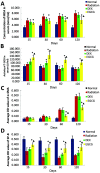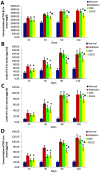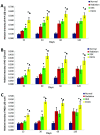The green tea extract epigallocatechin-3-gallate inhibits irradiation-induced pulmonary fibrosis in adult rats
- PMID: 24736877
- PMCID: PMC4072398
- DOI: 10.3892/ijmm.2014.1745
The green tea extract epigallocatechin-3-gallate inhibits irradiation-induced pulmonary fibrosis in adult rats
Abstract
The present study evaluated the effect of epigallocatechin-3-gallate (EGCG), the most abundant catechin in green tea, on irradiation-induced pulmonary fibrosis and elucidated its mechanism of action. A rat model of irradiation-induced pulmonary fibrosis was generated using a (60)Co irradiator and a dose of 22 Gy. Rats were intraperitoneally injected with EGCG (25 mg/kg) or dexamethasone (DEX; 5 mg/kg) daily for 30 days. Mortality rates and lung index values were calculated. The severity of fibrosis was evaluated by assaying the hydroxyproline (Hyp) contents of pulmonary and lung tissue sections post-irradiation. Alveolitis and fibrosis scores were obtained from semi-quantitative analyses of hematoxylin and eosin (H&E) and Masson's trichrome lung section staining, respectively. The serum levels of transforming growth factor β1 (TGF-β1), interleukin (IL)-6, IL-10, and tumor necrosis factor-α (TNF-α) were also measured. Surfactant protein-B (SPB) and α-SMA expression patterns were evaluated using immunohistochemistry, and the protein levels of nuclear transcription factor NF-E2-related factor 2 (Nrf-2) and its associated antioxidant enzymes heme oxygenase-1 enzyme (HO-1) and
Nad(p)h: quinone oxidoreductase-1 (NQO-1) were examined via western blot analysis. Treatment with EGCG, but not DEX, reduced mortality rates and lung index scores, improved histological changes in the lung, reduced collagen depositions, reduced MDA content, enhanced SOD activity, inhibited (myo)fibroblast proliferation, protected alveolar epithelial type II (AE2) cells, and regulated serum levels of TGF-β1, IL-6, IL-10, and TNF-α. Treatment with EGCG, but not DEX, activated Nrf-2 and its downstream antioxidant enzymes HO-1 and NQO-1. Taken together, these results showed that EGCG treatment significantly inhibits irradiation-induced pulmonary fibrosis. Furthermore, the results suggested promising clinical EGCG therapies to treat this disorder.
Figures








Similar articles
-
3,4-dihydroxyphenylethanol suppresses irradiation-induced pulmonary fibrosis in adult rats.Int J Clin Exp Pathol. 2015 Apr 1;8(4):3441-50. eCollection 2015. Int J Clin Exp Pathol. 2015. PMID: 26097528 Free PMC article.
-
Effects of lettuce glycoside B in ameliorating pulmonary fibrosis induced by irradiation exposure and its anti-oxidative stress mechanism.Cell Biochem Biophys. 2015 Mar;71(2):971-6. doi: 10.1007/s12013-014-0295-8. Cell Biochem Biophys. 2015. PMID: 25319075
-
Atractylenolide III attenuates bleomycin-induced experimental pulmonary fibrosis and oxidative stress in rat model via Nrf2/NQO1/HO-1 pathway activation.Immunopharmacol Immunotoxicol. 2020 Oct;42(5):436-444. doi: 10.1080/08923973.2020.1806871. Epub 2020 Aug 29. Immunopharmacol Immunotoxicol. 2020. PMID: 32762376
-
Ferroptosis as a molecular target of epigallocatechin gallate in diseases.Arch Physiol Biochem. 2025 Apr;131(2):156-168. doi: 10.1080/13813455.2024.2401892. Epub 2024 Sep 12. Arch Physiol Biochem. 2025. PMID: 39264116 Review.
-
Molecular Mechanisms of Epigallocatechin-3-Gallate for Prevention of Chronic Kidney Disease and Renal Fibrosis: Preclinical Evidence.Curr Dev Nutr. 2019 Aug 29;3(9):nzz101. doi: 10.1093/cdn/nzz101. eCollection 2019 Sep. Curr Dev Nutr. 2019. PMID: 31555758 Free PMC article. Review.
Cited by
-
Epigallocatechin gallate attenuates proliferation and oxidative stress in human vascular smooth muscle cells induced by interleukin-1β via heme oxygenase-1.Mediators Inflamm. 2014;2014:523684. doi: 10.1155/2014/523684. Epub 2014 Sep 7. Mediators Inflamm. 2014. PMID: 25386047 Free PMC article.
-
Green Tea Polyphenol (-)-Epigallocatechin-3-Gallate (EGCG): A Time for a New Player in the Treatment of Respiratory Diseases?Antioxidants (Basel). 2022 Aug 13;11(8):1566. doi: 10.3390/antiox11081566. Antioxidants (Basel). 2022. PMID: 36009285 Free PMC article. Review.
-
Monomeric compounds from natural products for the treatment of pulmonary fibrosis: a review.Inflammopharmacology. 2024 Aug;32(4):2203-2217. doi: 10.1007/s10787-024-01485-0. Epub 2024 May 9. Inflammopharmacology. 2024. PMID: 38724690 Review.
-
MicroRNA-27b Enhances the Hepatic Regenerative Properties of Adipose-Derived Mesenchymal Stem Cells.Mol Ther Nucleic Acids. 2016 Feb 2;5(2):e285. doi: 10.1038/mtna.2015.55. Mol Ther Nucleic Acids. 2016. PMID: 26836372 Free PMC article.
-
Epigallocatechin-3-gallate attenuates unilateral ureteral obstruction-induced renal interstitial fibrosis in mice.J Histochem Cytochem. 2015 Apr;63(4):270-9. doi: 10.1369/0022155414568019. Epub 2014 Dec 30. J Histochem Cytochem. 2015. PMID: 25549657 Free PMC article.
References
-
- Epperly MW, Guo H, Gretton JE, Greenberger JS. Bone marrow origin of myofibroblasts in irradiation pulmonary fibrosis. Am J Respir Cell Mol Biol. 2003;29:213–224. - PubMed
-
- Matsuo Y, Shibuya K, Nakamura M, et al. Dose-volume metrics associated with radiation pneumonitis after stereotactic body radiation therapy for lung cancer. Int J Radiat Oncol Biol Phys. 2012;83:e545–e549. - PubMed
-
- Minor GI, Yashar CM, Spanos WJ, Jr, et al. The relationship of radiation pneumonitis to treated lung volume in breast conservation therapy. Breast J. 2006;12:48–52. - PubMed
Publication types
MeSH terms
Substances
LinkOut - more resources
Full Text Sources
Other Literature Sources
Medical
Miscellaneous

